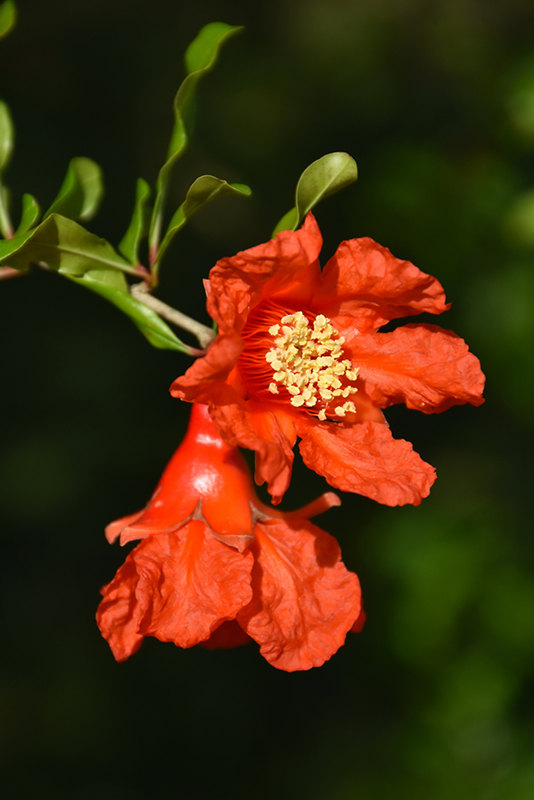Height: 15 feet
Spread: 10 feet
Sunlight:
![]()
Hardiness Zone: 7b
Description:
This vigorous, variety matures into a dense habit, producing orange-red flowers on the branch ends throughout summer, followed by yellow fruit that is flushed with red ; drought tolerant once established, this selection is great for sunny dry areas
Edible Qualities
Pomegranate is a large shrub that is typically grown for its edible qualities, although it does have ornamental merits as well. It produces yellow seeds (technically 'pomes') with a red blush and dark red flesh which are harvested in early fall. The seeds have a sweet taste and a juicy texture.
The seeds are most often used in the following ways:
- Fresh Eating
- Preserves
- Juice-Making
Features & Attributes
Pomegranate has nodding orange trumpet-shaped flowers at the ends of the branches from early to late summer, which emerge from distinctive tomato-orange flower buds, and which are interesting on close inspection. It has dark green deciduous foliage. The glossy oval leaves do not develop any appreciable fall color. The fruits are showy yellow pomes with a red blush, which are carried in abundance in early fall.
This is a dense multi-stemmed deciduous shrub with a mounded form. Its average texture blends into the landscape, but can be balanced by one or two finer or coarser trees or shrubs for an effective composition. This is a relatively low maintenance plant, and is best pruned in late winter once the threat of extreme cold has passed. It has no significant negative characteristics.
Aside from its primary use as an edible, Pomegranate is sutiable for the following landscape applications;
- Accent
- Mass Planting
- General Garden Use
- Container Planting
Planting & Growing
Pomegranate will grow to be about 15 feet tall at maturity, with a spread of 10 feet. It has a low canopy, and is suitable for planting under power lines. It grows at a slow rate, and under ideal conditions can be expected to live for approximately 30 years.
This shrub is quite ornamental as well as edible, and is as much at home in a landscape or flower garden as it is in a designated edibles garden. It should only be grown in full sunlight. It is very adaptable to both dry and moist growing conditions, but will not tolerate any standing water. It may require supplemental watering during periods of drought or extended heat. It is not particular as to soil pH, but grows best in rich soils. It is somewhat tolerant of urban pollution. This species is not originally from North America.
Pomegranate is a good choice for the edible garden, but it is also well-suited for use in outdoor pots and containers. Because of its height, it is often used as a 'thriller' in the 'spiller-thriller-filler' container combination; plant it near the center of the pot, surrounded by smaller plants and those that spill over the edges. It is even sizeable enough that it can be grown alone in a suitable container. Note that when grown in a container, it may not perform exactly as indicated on the tag - this is to be expected. Also note that when growing plants in outdoor containers and baskets, they may require more frequent waterings than they would in the yard or garden.
Disclaimer - This Plant Finder tool is an online resource representing many of the varieties that we carry over the course of the season, and is intended for informational purposes only. Inventory varies seasonally, so we cannot guarantee that every plant will be in stock at all times - please contact the store directly for current availability. It does not include our entire selection of plants, so be sure to visit our store to see varieties that may not be represented on this list.



